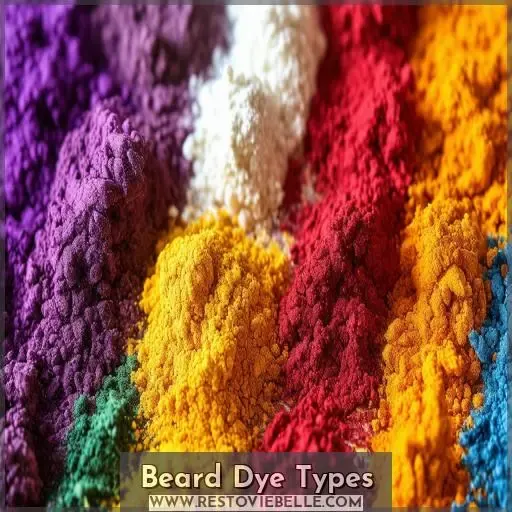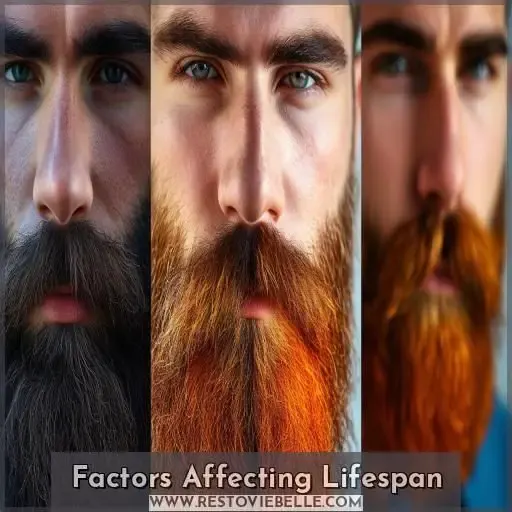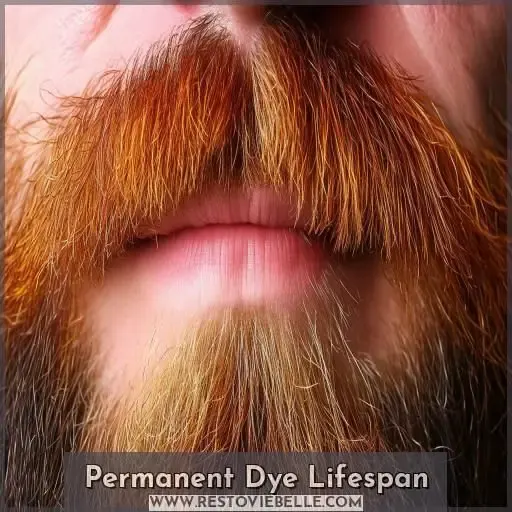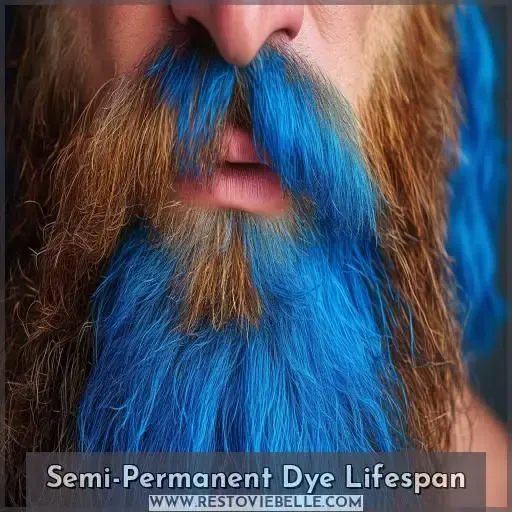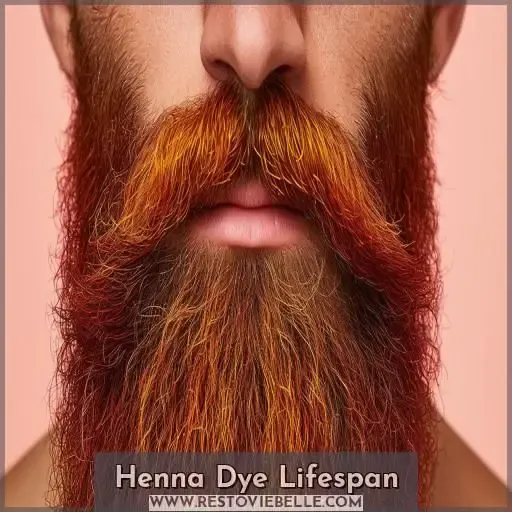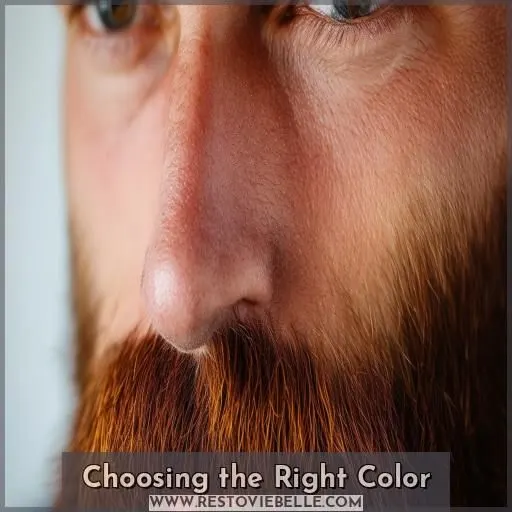This site is supported by our readers. We may earn a commission, at no cost to you, if you purchase through links.
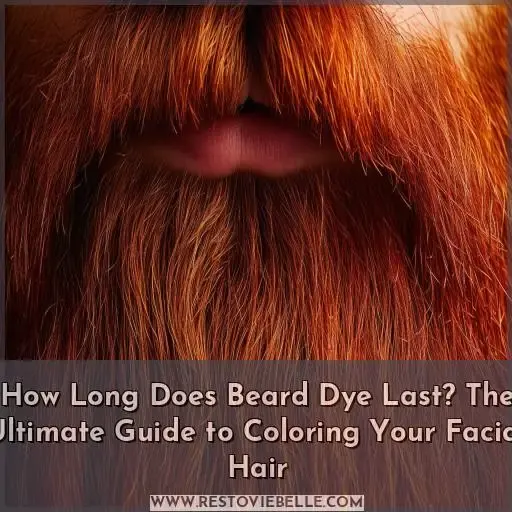 It depends on the type you choose.
It depends on the type you choose.
Permanent dyes penetrate deep, providing vibrant color for months before needing root touch-ups.
Semi-permanent options gradually fade over 4-6 weeks for a lower commitment.
Temporary dyes wash out within 1-2 days – perfect for a special occasion or experimenting.
But the lifespan also hinges on your hair type, care routine, and dye application.
Using the right products and techniques can maximize your new hue’s longevity.
Want to make sure your beard stays brilliantly colored?
Stick around to discover more factors impacting dye duration.
Table Of Contents
Key Takeaways
- Dye duration is like a firework display – permanent dyes are the grand finale, illuminating your beard for months, while semi-permanent and temporary options offer vibrant bursts before fading gracefully.
- Your hair’s texture and porosity play as big a role as the dye type itself. Coarse beards absorb color like a sponge, but the party’s over sooner as fresh grays emerge quickly. Fine, sleek strands hold onto that colored swagger for longer.
- A diligent care routine is the key to keeping that brilliant hue locked in. Think of it as watering and pruning a vibrant garden – nourishing oils and balms, regular trims, and avoiding harsh chemicals that zap the color.
- Choosing the right shade is an art form. Cooler skin tones rock those ashy browns like a smoky eye look, while warmer complexions slay those coppery, sun-kissed vibes. And don’t forget, darker hues can sculpt that jawline like a Renaissance masterpiece.
How Long Does Beard Dye Last?
How long does beard dye last? The lifespan of beard dye can range from a few days for temporary dyes to several weeks for semi-permanent and permanent dyes, depending on factors like hair texture and care routine.
Beard Dye Types
With an array of beard dye options, you can achieve your desired look.
Permanent dyes offer long-lasting color.
Semi-permanent dyes gradually fade for a more natural shift.
Temporary dyes are perfect for special occasions or experimenting with new shades.
If you prefer a natural approach, henna provides a warm, reddish tint.
Consider color swatches and trends when choosing your ideal hue.
Factors Affecting Lifespan
Regarding the longevity of beard dye, your hair type and texture play a significant role. A well-maintained beard care routine also affects the dye’s duration; employing quality products and minimizing exposure to harsh elements can prolong the color.
Hair Type and Texture
Your hair’s porosity and growth rate affect how long a beard dye lasts.
Coarse, porous facial hair absorbs color better, extending dye life. But it also grows faster, so gray hairs resurface quicker.
Fine, less porous beards don’t retain dye as vividly but stay colored longer due to slower growth.
Using a beard conditioner alongside the dye can boost longevity by sealing the hair cuticle.
Beard Care Routine
Your beard care routine greatly impacts dye longevity. Using beard oils, washes, and butters helps retain color vibrancy by keeping hair conditioned. Avoid harsh chemicals that strip dye. Trim regularly for even fading. A diligent routine with quality products maximizes your beard dye’s lifespan, ensuring you look your best without frequent redyeing.
Permanent Dye Lifespan
If you’re aiming for long-lasting color, permanent beard dye is your best bet. It deeply penetrates the hair shaft, providing vibrant results for several months.
However, you’ll need regular root touch-ups as your beard grows out. Proper product selection and patch testing are essential to avoid color fading or skin irritation.
With the right technique and quality products like beard oil and wash, a permanent dye can transform your beard’s appearance while looking natural.
Semi-Permanent Dye Lifespan
Semi-permanent beard dye is an ideal choice if you want vibrant, natural-looking color that lasts around 6 weeks. It offers:
- Rich, blended tones lasting 4-6 weeks
- Gradual, hassle-free fading
- Versatility for DIY touch-ups
- Conditioning ingredients for healthy beards
Apply semi-permanent dye evenly using a tint brush or applicator bottle. Combine it with proper prep, aftercare using beard oils/balms, and you’ll keep your semi-permanent color looking fresh for weeks.
Temporary Dye Lifespan
If you want a dye that washes out quickly, temporary beard dyes are perfect for experimentation. They last around 1-2 days before fading, allowing you to easily switch up your look.
These dyes are ideal for special occasions or if you have sensitive skin and want to test a color first.
Just keep in mind, with frequent washing and beard growth, you’ll need to reapply temporary dyes often to maintain the vibrancy. Unlike semi-permanent dyes, there’s no commitment – the color will be gone before you know it!
Henna Dye Lifespan
You’re considering henna dye for your beard? It’s a natural choice, providing a reddish-brown hue that typically lasts around 4 weeks.
However, frequent washing can fade the color faster.
The henna dyeing process is relatively simple – just apply the paste evenly for full coverage.
While henna is gentle, be mindful of potential hair damage.
With proper care, henna can invigorate your beard while covering grays naturally.
Choosing the Right Color
When choosing the right beard dye color, consider your skin tone – brownish and red shades generally suit lighter skin tones, while darker shades may complement deeper complexions better. Additionally, the shape of your face can influence the ideal shade; darker colors can create a slimming effect on round faces, while lighter hues may soften sharper jawlines.
Skin Tone Considerations
Matching your skin’s undertones is key for a natural beard look.
For cooler undertones, opt for ash or cool browns.
Warmer tones suit mahogany or golden-browns.
Olive complexions rock red-browns and auburns.
If going gray, use an ash or blue-based shade for realistic gray coverage.
Avoid drastically lighter or darker unnatural shades that lack depth.
Buy separate beard dye for perfect pigment saturation.
Face Shape Considerations
You want your beard dye to complement your face shape. Consider these tips:
- Round faces benefit from darker shades that slim the face contour
- Oval and square faces look great with most colors
- Slim faces can handle lighter shades to create width
- Match cool skin tones with ashy hues; warm tones suit golden browns
The right color adds dimension, contours your face, and enhances your overall look. With some thought into color matching and face shape, you’ll sport a flattering beard.
Frequently Asked Questions (FAQs)
How long does beard dye last on coarse hair?
Beard dye lifespan on coarse hair depends on the product type. Semi-permanent dyes last 2-3 weeks, while permanent options provide 4-6 weeks of coverage before requiring touch-ups. Proper preparation and aftercare are key to maximizing longevity.
Can beard dye cause allergic reactions or irritation?
Like swimming against a strong current, beard dyes can sometimes irritate sensitive skin. Before taking the plunge, do a patch test to avoid an allergic reaction from crashing your confidence.
Is there a safe way to dye beards at home?
Yes, you can safely dye your beard at home by using a beard dye kit made for men’s facial hair. Always do a patch test first to check for any allergic reactions. Follow the instructions carefully and take precautions like wearing gloves.
Whats the best method for removing stubborn beard dye?
Try using a clarifying beard shampoo and gently scrubbing with a toothbrush. If dye persists, make a baking soda paste to gently exfoliate. Be patient – it may take a few tries, but this approach avoids harsh chemicals.
Are there any natural alternatives to chemical beard dyes?
Absolutely, you can explore natural beard dyes made from ingredients like henna, indigo, coffee, and beet juice. While results may vary, they’re gentler alternatives to harsh chemicals.
Conclusion
Like a vibrant sunset painting the sky, your beard’s colored hue will eventually fade.
While how long does beard dye last depends on various factors like dye type, hair texture, and care routine. Selecting the right color and application technique can guarantee your facial hair remains brilliantly eye-catching for weeks or months.
Embrace the journey by understanding dye lifespans and investing in quality products to maintain your desired look effortlessly.
